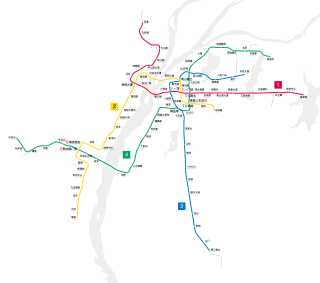
The Chengdu Metro is the rapid transit system of Chengdu, the capital of Sichuan, China. With the opening of Line 1 on 27 September 2010, the system has fifteen subway lines and one light rail line. It has subsequently undergone rapid expansion. Since the opening of Lines 6, 8, 9, and 17 on 18 December 2020, the Chengdu Metro is the 3rd longest metro system in the world.

Urban rail transit in China encompasses a broad range of urban and suburban electric passenger rail mass transit systems including subway, light rail, tram and maglev. Some classifications also include non-rail bus rapid transport.

Line 7 of the Beijing Subway is a rapid transit line in Beijing. It runs parallel and to the south of Line 1 and Batong line, from the Beijing West railway station in Fengtai District to Universal Resort in Tongzhou District. Like Line 6, Line 7 provides additional relief to the overcapacity Line 1 adding another east–west trunk line to the Beijing Subway network. The line uses 8-car Type B trains. Line 7's color is light orange.

Line 8 of the Beijing Subway is a rapid transit line in Beijing. It sits on the central axis of Beijing. Line 8's color is green. It is 49.5 km (30.8 mi) in length with 35 stations. The most recent extension is the central section from National Art Museum to Zhushikou, opened on 31 December 2021.

The National Forestry and Grassland Administration, concurrently known as the National Park Administration, is China's national bureau responsible for the supervision and management of forests, grasslands, wetlands, deserts, and terrestrial wildlife. It is managed by the Ministry of Natural Resources.

The Ministry of Civil Affairs the cabinet-level executive department of the State Council of China which is responsible for social and administrative affairs. It is the 10th-ranked department in the State Council. It was founded in its current form in May 1978, and the current minister is Lu Zhiyuan.

Shennongjia Forestry District is a county-level administrative unit in northwestern Hubei province, People's Republic of China, directly subordinated to the provincial government. It occupies 3,253 square kilometres (1,256 sq mi) in western Hubei, and, as of 2007 had the resident population estimated at 74,000. On July 17, 2016, Hubei Shennongjia was listed as a World Heritage Site, the 50th World Heritage Site in China, because of its exceptional floral and faunal biodiversity and its protection of many rare, endangered, and endemic species.
The Baoji–Lanzhou high-speed railway is a high-speed railway operated by China Railway High-speed between Baoji in western Shaanxi province and Lanzhou, the capital of Gansu province. The railway cut the rail travel between Baoji and Lanzhou from five hours to one hour and a half. It connects with the Xi'an–Baoji high-speed railway to the east and the Lanzhou–Urumqi high-speed railway to the west. The feasibility study report has been approved by the National Development and Reform Commission. The construction work was expected to start in the first half of 2011, but it actually started in October 2012. The line started operations on July 9, 2017.

The Zoigê Marsh, also known as the Ruo'ergai Marsh or the Songpan Grasslands, is located in the eastern part of the Tibetan Plateau and forms the largest high-altitude marsh area in the world.

Nanchang Metro, officially Nanchang Rail Transit, is a rapid transit system in Nanchang, Jiangxi, China. As of 2021, four lines are operational. The Metro opened for commercial operation in December 2015. The network is currently 128.3 km (79.7 mi) in length with 4 lines. A total length of 163 km (101.3 mi) of network is planned, with Line 5 which is currently under planning.

Xiamen Metro, officially branded as AMTR, is a rapid transit system serving Xiamen, Fujian, China. Line 1 began operation on 31 December 2017. Line 2 began operation on 25 December 2019. Line 3 began operation on 25 June 2021.
Haibei Qilian Airport is an airport serving Qilian County in Haibei Tibetan Autonomous Prefecture, Qinghai province, China. It is located 35 kilometres (22 mi) east of the county seat of Qilian. Construction began in July 2014, with an estimated investment of 1.203 billion yuan. Qilian airport was opened on 28 August 2018. It is the seventh civil airport in Qinghai.
Ulan Tuya is a female Chinese singer and songwriter of Mongolian ethnicity.

Zhejiang Yuhuan Economic Development Zone, also known as Yuhuan New Town (玉环新城), formerly known as Zhejiang Damaiyu Economic Development Zone (浙江大麦屿经济开发区), was originally the Damaiyu Taiwan Trade Zone (大麦屿对台贸易区), established in June 1992. It is a provincial-level economic and technological development zone located in Yuhuan City, Zhejiang Province, with jurisdiction over Damaiyu Port, Xuanmen Phase II, and Xuanmen Phase III. Within the administrative region of Yuhuan City, the jurisdiction is akin to a township-level unit.
The Ports of Entry of the People's Republic of China (中华人民共和国的口岸), according to the definition of "Several Provisions of the State Council on Port Opening", are the seaports, river ports, airports, railway stations, border crossings (边境通道), and all other entry-points through which people, goods, and means of transportation may legally enter and exit the country. Ports of Entry are legal entities and state institutions, and the opening or closing of ports of entry must be announced and implemented after approval by the State Council or by the provincial people's government. "Ports of Entry" are distinct entities to the associated transportation facility.
Lhasa Converter Station is the first ±400 kV converter station designed for high-altitude and cold-climate conditions. It is the largest of its kind, situated in Langtang Village, Lhünzhub County, Lhasa City, at an altitude of 3,825 meters. The station officially began operations on December 9, 2011, marking a significant milestone in addressing the power supply challenges faced by the Tibetan power grid at the time.
The Beijing Municipal Supervisory Commission, or Supervisory Commission of Beijing Municipal is a provincial-level local state supervisory authority in Beijing, co-located with the Discipline Inspection Committee of the Beijing Municipal Committee of the Chinese Communist Party. It was established in January 2017 to assume the functions of the former Beijing Municipal Supervisory Bureau. The director of the Beijing Municipal Supervision Commission is elected by the Beijing Municipal People's Congress and is accountable to both the Congress and its Standing Committee, as well as the Supervision Commission of the People's Republic of China.
The Shanxi Provincial Supervisory Commission, abbreviated as Shanxi Supervisory Commission (Chinese: 山西省监委, is a provincial-level local state supervisory authority in Shanxi Province, People's Republic of China, situated alongside the Discipline Inspection Committee of the Shanxi Provincial Committee of the Chinese Communist Party.
The Zhejiang Provincial Supervisory Commission, abbreviated as Zhejiang Supervisory Commission (Chinese: 浙江省监委, is a provincial-level local state supervisory authority in Zhejiang Province, People's Republic of China, situated alongside the Discipline Inspection Committee of the Zhejiang Provincial Committee of the Chinese Communist Party.

The People's Government of Jiangsu Province, or Jiangsu Province People's Government, is the provincial-level state administrative organ of Jiangsu Province, People's Republic of China.






















